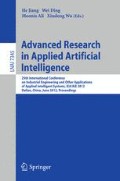Abstract
AIDA stands for animation and images to develop algorithms. It is a languge of algorithmic CyberFrames, Animation Scenes, and CyberFilms within the Filmification modeling (F-modeling) environment where pictures and moving pictures are used for the representation of features of computational algorithms and data structures. Generic pictures of the algorithmic super-characters are used to compose compound pictures defining algorithmic steps. The generic and compound pictures, as well as their series, are developed and acquired in special galleries of an open type where supportive pictures of embedded clarity annotations are also included. The acquisition is oriented to enhancing users perception, comprehension and cognition within works on developing application models, corresponding algorithms and programs. In this paper, a general scheme of the F-modeling environment on data/knowledge acquisition and examples of pictures from the galleries are presented. A new case of such acquisition related to program in pictures for the sparse matrix-vector multiplications is also presented and some technigues for creating embedded clarity annotations are explained.
Access this chapter
Tax calculation will be finalised at checkout
Purchases are for personal use only
Preview
Unable to display preview. Download preview PDF.
References
Engelbrech, A.P.: Computational Intelligence: An Introduction. Wiley (2002)
Chaudhuri, S., Dayal, U., Narasayya, V.: An Overview of Business Intelligence Technology. Communications of the ACM 54(8), 88–98 (2011)
Bernstein, P.A., Haas, L.M.: Information integration in the enterprise. Communications of ACM 51(9), 72–79 (2008)
Chaudhuri, S., Dayal, U., Ganti, V.: Database technology for decision support systems. IEEE Computer 34(12), 48–55 (2001)
Sugawara, K., Fujita, H.: On Knowledge Management System for Assisting User’s Decision in Office Work. In: New Trends in Software Methodologies, Tools and Techniques, pp. 159–165. IOS Press (2011)
Modha, D.S., Ananthanarayanan, R., Esser, S.K., Ndirango, A., Sherbondy, A.J., Singh, R.: Cognitive Computing. Communications of the ACM 54(8), 62–71 (2011)
Parnas, D.: The Risks of Stopping Too Soon. Communications of the ACM 54(6), 31–33 (2011)
Booch, G.: Draw me a picture. IEEE Software 28(1), 6–7 (2011)
Kindborg, M., McGee, K.: Visual programming with analogical representations: Inspirations from a semiotic analysis of comics. Journal of Visual Languages and Computing 18(2), 99–125 (2007)
Beckers, F.: Pictures worth a thousand tiles, a geometrical programming language for self-assembly. Theoretical Computer Science 410(16), 1495–1515 (2009)
Shneiderman, B.: Leonardo’s laptop: human needs and the new computing technologies. MIT Press (2002)
Yoshioka, R., Mirenkov, N.: Visual Computing within Environment of Self-explanatory Components. Soft Computing Journal 7(1), 20–32 (2002)
Mirenkov, N., Vazhenin, A., Yoshioka, R., Ebihara, T., Hirotomi, T., Mirenkova, T.: Self-explanatory components: a new programming paradigm. International Journal of Software Engineering and Knowledge Engineering 11(1), 5–36 (2001)
Watanobe, Y., Mirenkov, N., Yoshioka, R.: Algorithm Library based on Algorithmic CyberFilms. Journal of Knowledge-Based Systems 22(3), 195–208 (2009)
Watanobe, Y., Mirenkov, N., Yoshioka, R., Monakhov, O.: Filmification of methods: A visual language for graph algorithms. Journal of Visual Languages and Computing 19(1), 123–150 (2008)
Watanobe, Y., Yoshioka, R., Mirenkov, N.: Cognitive Aspects of Programming in Pictures. In: Mehrotra, K.G., Mohan, C.K., Oh, J.C., Varshney, P.K., Ali, M. (eds.) IEA/AIE 2011, Part II. LNCS (LNAI), vol. 6704, pp. 11–20. Springer, Heidelberg (2011)
Sparse matrix, http://en.wikipedia.org/wiki/Sparse_matrix
Author information
Authors and Affiliations
Editor information
Editors and Affiliations
Rights and permissions
Copyright information
© 2012 Springer-Verlag Berlin Heidelberg
About this paper
Cite this paper
Watanobe, Y., Gu, L., Mirenkov, N. (2012). Intelligent Aspects of AIDA Programming. In: Jiang, H., Ding, W., Ali, M., Wu, X. (eds) Advanced Research in Applied Artificial Intelligence. IEA/AIE 2012. Lecture Notes in Computer Science(), vol 7345. Springer, Berlin, Heidelberg. https://doi.org/10.1007/978-3-642-31087-4_49
Download citation
DOI: https://doi.org/10.1007/978-3-642-31087-4_49
Publisher Name: Springer, Berlin, Heidelberg
Print ISBN: 978-3-642-31086-7
Online ISBN: 978-3-642-31087-4
eBook Packages: Computer ScienceComputer Science (R0)

